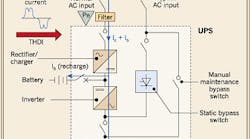No electricity provider in the world can guarantee an electrical supply that is free from voltage and frequency variations. The possibility of faults occurring in user installations or in the public distribution system remains undeniable and unpredictable.
Because an information technology (IT) installation is particularly sensitive to power supply fluctuations and distortions, it typically relies on an uninterruptible power supply (UPS) to mitigate the effects of these phenomena (Fig. 1). Some installations even include a second UPS supplied by a separate feeder and a standby generator that can be set to start automatically 3 minutes after detecting a power interruption. If the risk from weather or other local occurrences is great enough, some facilities will manually switch over to backup generation ahead of time.
To help your contingency supply system function as designed, you should perform certain tests during installation and then periodically (monthly or quarterly, depending on contractual agreements) after your system is commissioned. Tests during the installation phase are divided into two stages: pre-installation and combined. Let's see what's involved with both types of tests.
Pre-installation testing
This includes testing done before connecting the critical loads.
UPS functional and alarms testing
The purpose here is to check the UPS functionality, LED display, and alarm messages.
UPS specification testing
This step requires checking and measuring the UPS specification. You'll need two 3-phase power quality analyzers for this — one for measurements at the output and the other at the input. The procedure is to record voltage, current, real power, apparent power, power factor, voltage, and current total harmonic distortion (THD) at both points. Then, vary the loads from 0% to 100% in 25% incremental steps for balanced load testing. For unbalanced load testing, follow the load matrix shown in the Table.
UPS burn-in test
This is done to verify that the UPS system can operate at the rated load under ambient room temperature conditions. The procedure here is to load the UPS to rated load and operate it from 8 hours to 24 hours, depending on contractual requirements.
UPS step load and bypass loss transient tests
The purpose of this testing is to demonstrate the transient response of the UPS module. Here, we measure UPS transient response for:
-
0% to 100% to 0% load steps,
-
0% to 50% to 0% load steps,
-
50% to 100% to 50% load steps, and
-
UPS running with loss of bypass mains.
In the example shown in Fig. 2 and Fig. 3, the 3-phase voltage waveform hardly varies, despite the 100% change in load current.
UPS start and stop test
This test demonstrates correct operation when the UPS is switched on and off with full load. With the UPS module running at 50% and 100% load, you switch the inverter off and on and record transients, load voltage, load current, Mains 2 current, and Mains 1 current.
UPS full load battery discharge test
This is done to demonstrate correct UPS operation for 15 minutes at full load during a power failure. The procedure involves measuring battery cells before and after discharge using a battery monitoring system.
UPS loss and return of mains test
Here, we're trying to demonstrate correct operation during loss and return of the mains. The procedure involves running the UPS module at normal load and switching the UPS main input on and off, recording transients, load voltage, load current, and Mains 1 current.
UPS loss and return of battery test
The purpose of this test is to demonstrate correct operation during loss and return of UPS batteries. Here, you run the UPS module at normal load and switch the UPS main battery breaker on and off, recording transients, load voltage, load current and Mains 1 current.
UPS load transfer test
Here, we're verifying the correct UPS operation during load transfer by running the module at normal load and switching the UPS off and on until the load is on static bypass. You then reverse this procedure from static bypass to UPS and record load voltage, load current, and bypass current.
UPS transfer to bypass and back test
The purpose of this test is to demonstrate correct UPS operation with external bypass by transferring the load to external bypass and back to UPS and recording load voltage and load current.
Combined testing
This testing is done by connecting critical loads and testing while cutting the standby generator in and out. Basically, you're connecting the critical loads and standby generator, repeating the same tests at 0% and 100% load conditions, and monitoring transfer between the mains supply, UPS, and standby generator to ensure that transients and waveform distortion stay within acceptable limits.
From this point forward, you'll need to perform maintenance tests. You conduct periodic (monthly) maintenance tests throughout the life of the contingency supply system and follow the combined test procedure for everything except the standby generator — it only needs to be tested once a year.
Many tests are involved when commissioning and maintaining a contingency supply system. You must simultaneously log many parameters (3-phase voltage and current, power, power factor, harmonics, and transients) over 8 hours to 24 hours and document these parameters in report format using a power quality analyzer with data logging and reporting capabilities.
Author's note: MGE personnel typically perform the tests noted above during their installation, commissioning, and maintenance practices. Fluke thanks them for their contributions to this article.
Ong is a power quality specialist with Fluke in Everett, Wash.







